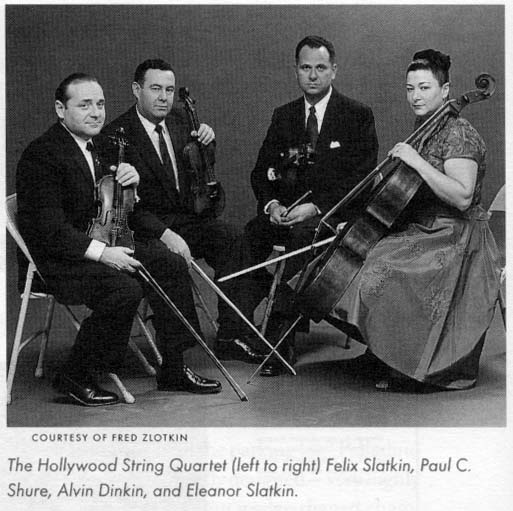

The Hollywood String Quartet
(HSQ)
was a superior group comprising four of
the
most reliable session musicians in Hollywood: Felix Slatkin (violin),
Paul
C. Shure (violin), Alvin Dinkin (viola), and Eleanor Slatkin (cello).
All
were Hollywood film studio players, who fulfilled their passion for
classical
repertory by playing together in their offtime. "In 1939, I became the
first cellist at Warner Brothers," recalled Eleanor Slatkin. "Felix and
I married, then formed the Quartet. The original group was Felix,
Joachim
Chassman, Paul Robyn, and me. Then Felix went into the army in 1941,
and
there went the Quartet! When he came out of the service in 1945, Felix
continued as concertmaster at Twentieth Century Fox, and we started the
Quartet again."
The 1945 group replaced Chassman with Paul C. Shure
(at
that time assistant concertmaster at Fox, he is the sole surviving
member
of the Quartet). During the next nine years, the group gained
widespread
recognition. "We were the most famous American quartet - the
first
ever, in fact, to be invited to the Edinburgh Festival," Shure
recalled.
"We went at it `hammer and tongs,' and rehearsed almost every day,
creating
a fine quartet that became world famous more on the strength of its
recordings
than anything else." The original vinyl pressings of their LPs are
highly
prized collectibles today.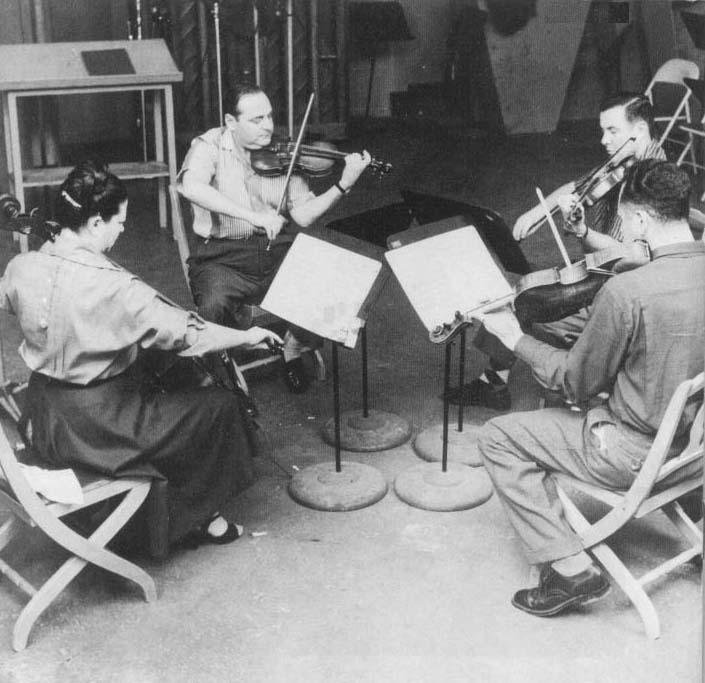
Far from 'a stuffy ensemble dedicated solely to "longhair" music, the four were busy session musicians who contributed to everv aspect of the Hollywood music scene. "We were affiliated with Capitol and had an agreement to do all the commercial records to make money, because we certainly didn't make money from the Quartet!" Eleanor maintains. "Early rock-and-roll, jazz, and pop albums; TV and film scores . . . we did it all," says Shure.
"The advantage of being a studio musician was that you were under contract, and like a symphony orchestra musician, you worked approximately twenty-two to twenty-four hours a week, and had a great deal of free time to pursue other interests. Hence, my parents were able to not only have a decent living by working in the studios, but it provided them with a means to establish one of the great quartets of our time," explains Leonard Slatkin.
"Outside of the fact that each person in his own right was an extremely capable instrumentalist was the flexibility that we had. We could play all different styles of music, without having to reach for it. Eleanor was a damned good commercial player-she had a real sense for the style of commercial music," Shure says. "Curiously, even though we were extremely active in the Hollywood scene, the name `Hollywood String Quartet' had nothing to do with `Hollywood' music. We all happened to be from Hollywood, and no one ever had a quartet from there that made anything of themselves. So, we said, `Why not?' Instead of `The Los Angeles String Quartet,' we'll call ourselves `The Hollywood String Quartet."'
Listening to the quartet's recordings of works by
Ravel,
Schubert, Beethoven, Borodin, and Schoenberg (among many others), one
immediately
understands what attracted Sinatra, and why he found the notion of
recording
with the group so appealing. The four principals created a sound that
had
a luxuriant glow. "In the Quartet, we made room for each other
technicallv
and soloistically-but the blend of sound was the main thing. You either
have it or you don't; it's a product of instinct and hard work- So
percent
of each, really," Shure observes. "We were like a family for many
years.
Eleanor was a wonderful player-she had the most beautifully rich, warm
sound and absolutely perfect intonation. Felix had a great sense of
timing
and a sense for phrasing a long phrase. In a quartet, all four people
have
to be of the same caliber, or it doesn't work . . . . You draw the
sound
by your ability: the kind of vibrato you use, the way you apply
pressure
to the bow . . . these are all very subtle techniques in string
playing.
I have no. guilt or false pride when I say we had four wonderful
players."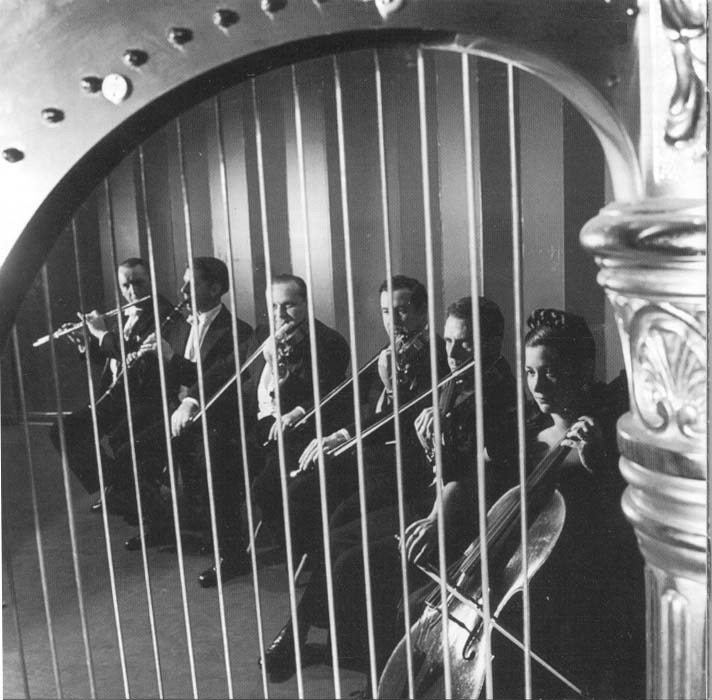
Leonard Slatkin explained the importance of similar music "training," which differs from country to countrv and ultimately affects the player's technique and the resultant sound of the ensemble. "I think when musicians get together, many times the question of `backgrounds' never comes up, and you have disparate kinds of chamber music institutions: people from a French school mixed with someone from a Russian school mixed with someone from a German school." "With the Hollywood String Quartet, you had four people who basically had the same kind of training, four people who were more or less of the same age group and who approached music in almost identical ways. The manner in which they played and practiced individually was quite different. My father, for instance, hardly ever practiced. He could just pick up a violin after three or four weeks off (if he had such a thing), and produce an extraordinary Tchaikovsky concerto. My mother always resented that he didn't have to work so hard; she had to practice like a dog, about four or five hours a day."
By 1954, the original violist, Paul Robyn, had left
to
pursue family interests, and his substitute was another Fox Studio
colleague,
Alvin Dinkin. Throughout the group's various incarnations, Felix
Slatkin
was the glue that held it together. "Felix was a wonderful violinist,
and
probably, to some degree, a frustrated man. I think he would have loved
to have had a conducting career," remembered Shure. (Slatkin had in
fact
studied conducting, under Fritz Reiner of the Chicago Symphony
Orchestra.
Apart from the Quartet, Slatkin conducted numerous albums of orchestral
music for the Hollywood Bowl Orchestra and for Liberty Records.)
(click here for details of the HSQ’s involvement in the classic Frank Sinatra album "CLOSE TO YOU")
(from "Sessions with Sinatra" by Charles Granata, published by A Cappella Books 1999)
LINKS:
Article
in Journal of Recorded Music
1955
New Yorker ad
for HSQ recordings
Eleanor Aller obituary: New
York
Times The
Independent
PHOTOS AND SCANS:
Listening to a
playback in the studio
Ad congratulating
all Capitol Records 1958 Grammy Winners, including both Felix Slatkin
and the Hollywood String Quartet
Closeup of Felix
Closeup of HSQ
Eleanor
Slatkin's name appears in the list of studio musicians known as "The
Wrecking Crew" in the film documentary by that name
Link to web page
with information about the documentary
ELEANOR SLATKIN INTERVIEW EXCERPTS:
THE HOLLYWOOD STRING
QUARTET on MP3 Download:
Cover of Smetana/Glazunov MP3 album
- Ordering
information
Cover of Ravel/Debussy/Schoenberg MP3
album - Ordering
information
THE HOLLYWOOD STRING
QUARTET
on COMPACT DISC:
TESTAMENT SBT 1031
Schoenberg: Verklärte Nacht
for string sextet, Op. 4
Schubert: Quintet for 2 violins,
viola & 2 cellos in C major, D. 956 (Op. posth. 163)
TESTAMENT SBT 1052
Prokofiev: String quartet No. 2
in F major, Op.92 "Kabardinian"
Hindemith: String Quartet No. 4
in C major, Op.16
Walton: String Quartet No. 2 in
A minor
TESTAMENT SBT 1053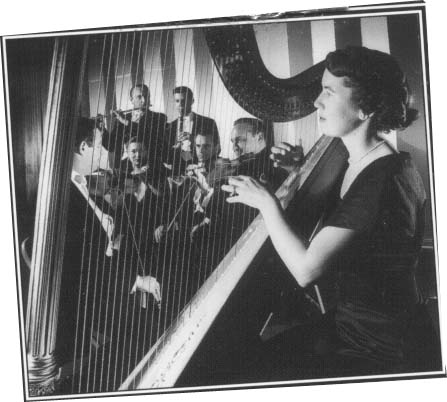
Ravel: Introduction and Allegro
Debussy: Danse Sacree et Danse
Profane
Turina: La Oracion Del Torero
Villa-Lobos: String Quartet No.
6
Creston: String Quartet
(with Ann
Mason Stockton, harp; Arthur Gleghorn, flute: Mitchell Lurie, clarinet)
Cover of original LP of works for string quartet with harp Front Cover Back Cover
TESTAMENT SBT 1061
Tchaikovsky: String Quartet No.
1
Borodin: String Quartet No. 2
Glazunov: Five Novellettes for
String Quartet
TESTAMENT SBT 1072
Kodaly: String Quartet, No 2, Op
10
Smetana: String quartet, No 1 In
E minor "From My Life"
Dvorak: String Quartet No. 12 in
F major ("American"), Op. 96
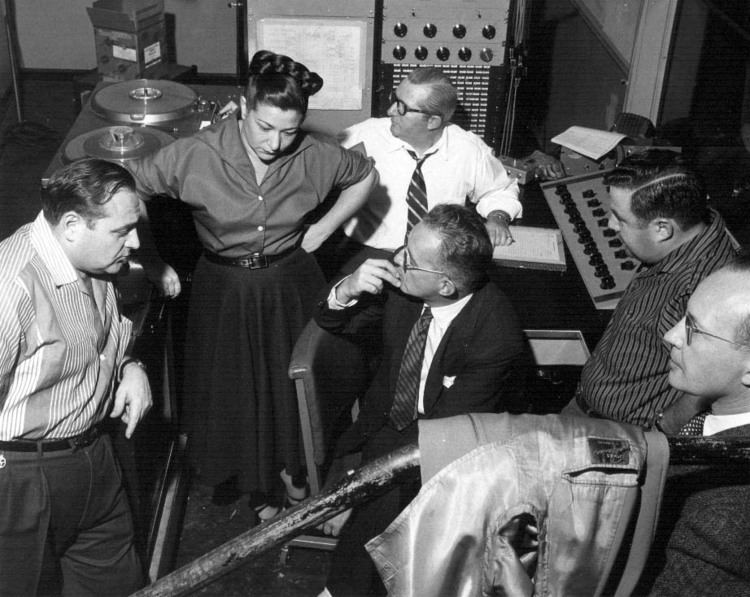 TESTAMENT SBT 1077
TESTAMENT SBT 1077
Shostakovich: Quintet for piano
& strings in G Minor, Op 57
Franck: Piano Quintet in F minor,
M7
(with
Victor
Aller, piano)
TESTAMENT SBT 1081
Wolf: Italian Serenade for string
quartet in G major
Dohnanyi: String Quartet No
3 in A minor, Op 33
Schubert: String Quartet No. 14
in D minor ("Death and the Maiden"), D. 810
TESTAMENT SBT 1085
"The Legendary London Live
Recordings"
Haydn: Quartet for 2 violins,
viola
& cello No. 61 in D minor "Fifths"/"The Bell'/"The
Donkey"
Op.
76/2,
H.
3/76
Mozart: String Quartet No. 17 in
B flat major ("Hunt"), K. 458
Hummel: String Quartet, No 2 in
G, Op 30/2
TESTAMENT SBT 3063 (3 CD
SET)
Brahms: Piano Quartet No. 1, No.
2, No. 3
Brahms: String Quartet No. 2
Brahms: Piano Quintet
(with
Victor
Aller, piano)
TESTAMENT SBT 3082 (3 CD
SET)
Beethoven: Quartet for 2 violins,
viola & cello No. 12 in E flat major, Op. 127
Quartet
for
2
violins,
viola
&
cello No. 14 in C sharp minor, Op.
131
Quartet
for
2
violins,
viola
&
cello No. 13 in B flat major
("Leib")
Op. 130
Fugue
for
string
quartet
in
B
flat major ("Grosse Fuge"), Op. 133
Quartet
for
2
violins,
viola
&
cello No. 15 in A minor ("Heiliger
Dankgesang")
Op. 132
Quartet
for
2
violins,
viola
&
cello No. 16 in F major, Op. 135
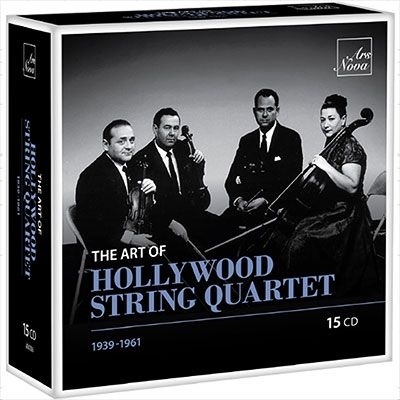 THE HOLLYWOOD STRING
QUARTET:
THE HOLLYWOOD STRING
QUARTET: Ravel
and
Debussy Later
LP
(including
Schoenberg)
Italy
LP
(including
Schoenberg)
Beethoven:
Late
Quartets
(Set
3)
Schubert:
Death
and
the
Maiden
Hindemith
and
Prokofiev UK
LP
cover
Schoenberg:
Verklaerte
Nacht Back
cover
45
RPM
single:
Tchaikovsky:
Andante
Cantabile
/
Borodin:
Nocturne
Back
cover Label
Side
1 Label
Side 2
UK
LP
Box
Set
of
Beethoven
Quartets
(EMI
RLS
7707)
NEWSPAPER ARTICLES ABOUT
THE HOLLYWOOD STRING QUARTET
1953-04-24
Bakersfield
Californian
1954-11-28 San Francisco Examiner
1955-11-13 Fort Lauderdale News
1956-11-18 Fort Lauderdale News
1957-02-02 Pittsburgh Sun Telegraph
(Sinatra)
1957-03-31 St. Louis Post-Dispatch
(Sinatra)
1957-11-21 Los Angeles Times
1958-01-25 Desert Sun
1958-03-09 Miami Herald Sun
1959-06-14 Tampa Tribune
1982-03-21 Los Angeles Times
Back to the
Felix Slatkin Web Page